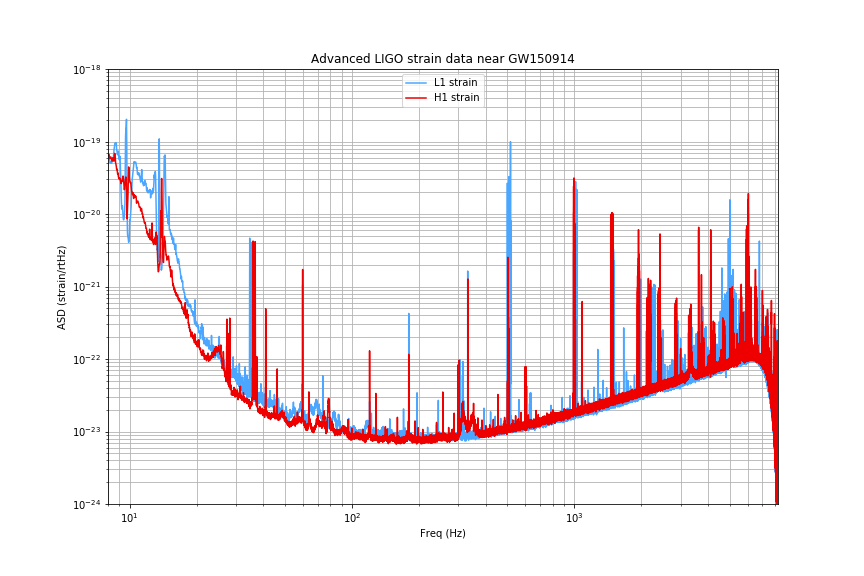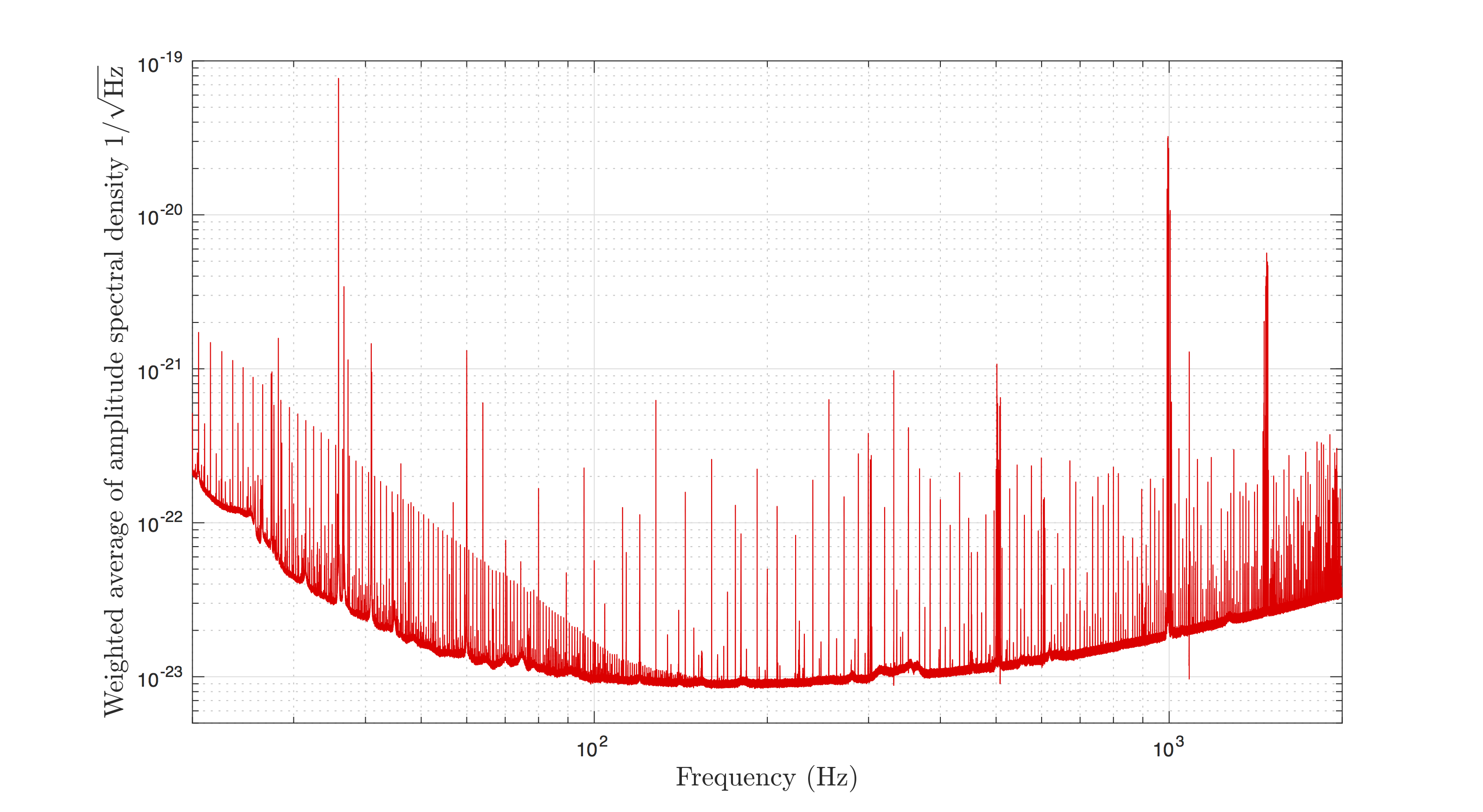O1 Instrumental Lines
The plot below shows the amplitude spectral density (ASD) of the strain noise in the H1 and L1 Advanced LIGO detectors, during a "typical" time in the O1 run. The plot shows frequency [Hz] on the X-axis, and the ASD value [ 1 / sqrt(Hz) ] on the y-axis. The first thing to note is that the data are not calibrated or valid below 10 Hz or above 5 kHz (and the data sampled at 4096 Hz are not valid above 2000 Hz).
The spectra reveal a large number of "lines" due to instrumental artifacts:
Impact on astrophysical searches
The excess noise from these instrumental spectral lines will obscure gravitational wave signals in that band, negatively impacting searches for signals. The lines can be variable in amplitude, frequency, and phase. Most searches for gravitational wave signals "notch out" those bands in one way or another. Since these lines are narrow, they do not present a major problem for searches for broad-band transients such as compact object mergers.
Note that continuous waves (CW) from non-axisymmetric spinning neutron stars are expected to appear as narrow spectral lines. Their frequency should be modulated by the Doppler shift due to the motion of our detectors with respect to the source; this is a small (part in 10^4) effect. LSC searches use matched filtering over the full observation time to identify potential CW signals in the data. Although most of the instrumental lines are stationary in frequency and hence do not exhibit the Doppler modulations due to the Earth’s motion expected for a CW signal from most sky locations, the lines pollute the spectrum for such sources. CW searches use a variety of methods to cope with this contamination (see references below).
Effort is put into understanding the instrumental origin of these lines, and engineering the detectors to keep the line bandwidth as narrow as possible. Line investigations are ongoing as we make hardware changes to mitigate and/or test coupling mechanisms of noise sources and strain data. Some details on the instrumental origin of these lines are given below.
The most prominent peaks
The peaks that are most noticeable to the eye are all believed to be due to known instrumental effects:
- 60 Hz power line harmonics around 60*n Hz, due to upconversion of low-frequency sesimic noise. These arise due to imperfect electromagnetic shielding, and magnetic coupling to the mirror suspensions.
- Thermally excited mirror suspension "violin modes" at ~500 Hz and and harmonics (1000, 1500, 2000 Hz). There is a "forest" of them due to the numerous mirror suspension fibers in the LIGO interferometers. These are an unfortunate but inevitable part of the LIGO detector design.
- The bounce and roll modes of the mirror suspensions at ~9 Hz and 13.8 Hz, respectively.
- Violin modes for the suspensions that hang the beam splitter around 300, 600, and 900 Hz.
-
Calibration lines inserted by moving the end mirrors. Calibration lines
during O1 were at:
- H1: 35.9000, 36.7000, 37.3000, 331.900, 1083.700 Hz
- L1:33.7000, 34.7000, 35.3000, 331.300 , 1083.100 Hz
- OMC dither lines: During O1 (more precisely, during Engineering Run 8, which immediately preceded O1 and is included in this data release), there were "dither lines" added to the L1 data through the control system, in order to facilitate coupling of the main laser beam to the Output Mode Cleaner (OMC). Early on (September 12-13, just before GW150914), these lines were at 600.1, 625.1, 650.1 and 675.1 Hz. After Sep 13, 2015, they were moved to 2225.1, 2250.1, 2275.1 and 2300.1 Hz for the remainder of O1.
Combs of lines
In both Advanced LIGO detectors, there are "combs" of lines, evenly spaced and extremely narrow, and typically in exact multiples of some fundamental frequency (like 1.0000 Hz). They are not visible in the plot above, but can be made visible in very high resolution spectra with careful averaging over the entire run. An example from H1 using 7200 second averaging over all of O1 is here:
Instrumental combs include:
- An 8-Hz comb in H1 with the even harmonics (16-Hz comb) being especially strong, which was later tracked down to digitization roundoff error in a high-frequency excitation applied to servo-control the cavity length of the Output Mode Cleaner (OMC)
- A set of lines found to be linear combinations of 22.7 Hz and 25.6 Hz in the L1 data was tracked down to OMC excitation at a still higher frequency, for which digitization error occurred
- The low-frequency band of the H1 and L1 data (below ∼140 Hz) was heavily contaminated by combs with spacings of 1 Hz, near-1-Hz and 0.5-Hz and a variety of non-zero offsets from harmonicity. Many of these lines originated from the observatory timing system, which includes both GPS-locked clocks and free-running local oscillators. These couplings were reduced following O1 via isolation of power supplies, and in some cases, reduction of periodic current draws in the timing system itself (blinking LEDs)
In addition to spectral lines whose instrumental origin is identified, there are other narrow "features" in the spectrum whose origin remains unknown. All of these features are rejected by the CW searches conducted by the LSC, because they do not exhibit the expected Doppler modulation, may exhibit very different amplitude and frequency modulation, and/or are not seen with consistent amplitudes in other detectors; we conclude that they are instrumental lines of unknown origin. As mentioned above, since these combs are extremely narrow, they have no significant impact on searches for broad-band transients.
References
- "Identification and mitigation of narrow spectral artifacts that degrade searches for persistent gravitational waves in the first two observing runs of Advanced LIGO" Phys. Rev. D 97, 082002;
- "All-sky Search for Periodic Gravitational Waves in the O1 LIGO Data" on arXiv;
- S6 detector characterization paper Class. Quant. Grav. 32:11,2015 (on arXiv);
Instrumental line catalog
The following files contain lists of prominent spectral line frequencies, their signal strength and signal-to-noise ratio, and our identification of their instrumental origins (where known). The intent is to identify spectral lines that we are confident are of instrumental (not astrophysical) origin, even if we don't understand the mechanism by which they show up in the strain data; they therefore are safe to ignore or "clean" (remove in an analysis-dependent way) when searching for CW signals.
These lists are restricted to only those lines of known instrumental origin or of unknown instrumental origin but showing characteristics inconsistent with astrophysical origin, based on single-interferometer data. Line artifacts are not marked as instrumental merely because they are not consistent between H1 and L1, although that inconsistency is used in excluding some outliers from CW searches. Hence residual unmarked lines can still be found in average spectra.
- Text file line catalogs:
It is likely that you will need to speak with a LIGO expert to understand the details of what you find in this catalog. You can start by checking our contact page.


